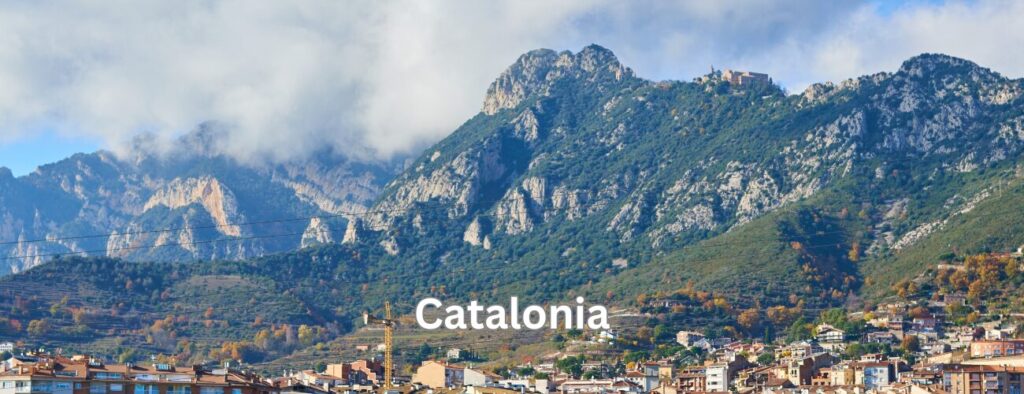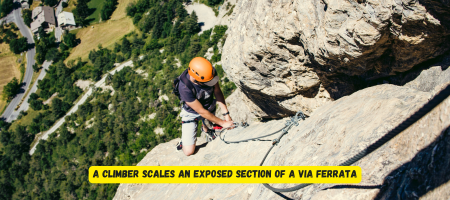Via Ferrata Cágate Lorito: An unforgettable Adventure in the heart of Catalonia.
Tucked into the rugged limestone cliffs of Sant Feliu de Guíxols in Catalonia, Via Ferrata Cágate Lorito is as unforgettable as its name suggests—literally translated as “Sh*t Yourself, Parrot.” This colorfully named route is not just a test of nerves, but an example of clever route design, athletic climbing, and stunning coastal views.
It is part of the broader network of via ferrata routes in Catalonia—one of Europe’s most active via ferrata regions. Cágate Lorito is a technical, exposed, and highly physical ferrata that has become a must-do for advanced climbers and adventure junkies. It is not a beginner-friendly route like the nearby Cala del Molí. This one is made for those who want vertical exposure, powerful moves, and the satisfaction of pushing their limits.

Where is it?
- Location: Sant Feliu de Guíxols, Girona province, Catalonia, Spain
- Coordinates: 41.7781° N, 3.0367° E
- Access: Free parking available near Cala del Molí. Approach after a short hike (~20 minutes) along the coast and through a small pine forest.
This ferrata is along the Costa Brava, one of Spain’s most spectacular coastal regions. The Mediterranean Sea is below the route, giving climbers not just adrenaline, but unforgettable views as well.
Click here to learn of another awesome Via Ferrata in Spain.
Route Overview
- Difficulty: K5+ (advanced/expert)
- Length: Approx. 300 meters of cable
- Vertical Gain: ~100 meters
- Route Time: 2 to 3 hours
- Type: Sporty and vertical; features overhangs, a hanging net, and a zip line
- Return: Hiking path to the parking lot (~30 minutes)
Cágate Lorito is not for beginners. The route has multiple athletic sections with large overhangs, dynamic moves, and creative installations like a “spider web” net and a cable bridge. If you’ve only done basic ferratas, you’ll want to build up your strength and technique before attempting this one.
A Step-by-Step Experience
The Approach
The route starts just inland from Cala del Molí, following a marked trail through Mediterranean brush and pine trees. You’ll pass a short section of handline-assisted walking before coming to the base of the cliff. As you gear up, you’ll already feel the exposure—this is coastal climbing at its most raw.
Section 1: Vertical Ignition
The route wastes no time. The first section shoots straight up a near-vertical wall with sparse holds. The iron staples are well-placed but demand strong arms and solid footwork. The exposure builds quickly, with the sea below and the cliffs above closing in.

Section 2: Traverse of Terror
One of the best sections is a horizontal traverse with a steep drop below. You’ll have to rely on natural rock holds and spaced-out steps. This part tests your balance and your head for heights. It’s also incredibly photogenic—if you’re brave enough to take your hand off the cable.
Section 3: The Overhang
Now comes the route’s defining feature: a bulging overhang that requires both strength and commitment. This is where many climbers feel the burn, especially if they’re not used to pulling up and out. The overhang is well-equipped with large steps, but you’ll need to use momentum and confidence to power through.
Click here for info about a fantastic selection of European adventures.
Section 4: The Spider Web
At the top of the overhang, you’re met with a unique installation: a metal net hanging vertically across a void. You must climb it like Spider-Man, using your whole body to navigate across the swinging structure. It’s fun, challenging, and absolutely wild. Few ferratas in Spain (or Europe) have something so unusual.
Section 5: Zip Line and Escape Option
At the end of the net, you’ll have two options:
- Zip line: A short but exciting descent by zip line—if you brought your pulley.
- Escape route: A walking path for those who wish to skip the final vertical push.
If you choose the zip line, make sure your gear includes a via ferrata pulley, as it’s not always provided. The line is short but exhilarating and you land on a narrow ledge that leads to the final climb.
You need to be in good condition for Via Ferratas. Click here to kick start your health and fitness.
Final Section: Airy Finish
The last part includes another exposed traverse and a vertical climb that leads to the top of the cliff. From here, you’re treated to panoramic views of the Costa Brava and the sea beyond. It’s the perfect end to a physically demanding adventure.
If you want a selection of practical, stylish and outdoors appropriate menswear, click here.
What You’ll Need
Because of its difficulty and the potential for long air-time, proper gear and experience are essential:
Required Gear
- Helmet
- Climbing harness
- Y-shaped via ferrata lanyard with energy absorber
- Climbing gloves (recommended for grip and safety)
- Sturdy approach shoes or climbing shoes with grip
- Pulley (for zip line section, optional but fun)
Recommended Gear
- Chalk bag (if you sweat on overhangs)
- Lightweight backpack with water and snacks
- Action camera for capturing the view
If you want to lose weight before attempting Via Ferratas, click here.
Tips and Safety Notes
- Do not attempt if you’re a beginner. This ferrata is designed for experienced climbers with strong upper body strength.
- Test your limits but know your escape routes. There are a couple of exits along the way if needed.
- Avoid in summer heat. The sun can be intense and there’s little shade.
- Don’t forget your pulley if you want to enjoy the zip line.
- Start early in the day to avoid crowds and allow plenty of time.
Nearby Attractions
After such a mad climb, you might want to relax and explore the area. The Costa Brava is rich with culture, food, and sea views.
- Cala del Molí: One of Europe’s only sea-cliff via ferratas and far more beginner-friendly.
- Sant Feliu de Guíxols: A charming coastal town with excellent restaurants and seaside promenades.
- Camí de Ronda coastal trail: Stunning hiking path that runs along the coast with dramatic cliff views.
- Beaches like Platja de Sant Pol: Great for a post-climb swim.
- Dali Triangle: Explore Salvador Dalí’s surreal legacy nearby in Figueres, Púbol, and Cadaqués.
Final Verdict
Via Ferrata Cágate Lorito is one of Spain’s boldest, most technical via ferratas—a wild ride of vertical walls, dramatic overhangs, and creative obstacles. For experienced climbers, it’s a playground of power and precision perched above the Mediterranean.
Whether you come for the challenge, the bragging rights, or the stunning views, one thing is certain: you won’t forget the day you climbed the parrot.


